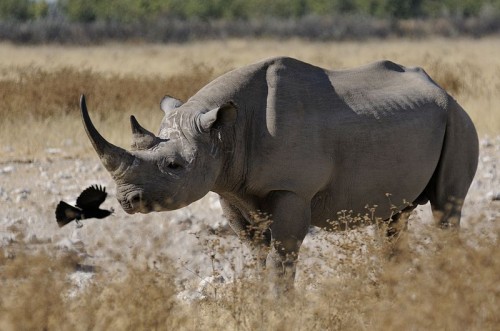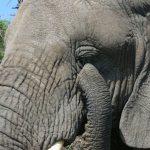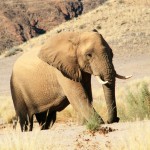
The rationale behind the permit to hunt a black rhino in Namibia — which fetched $350,000 at an auction held by the Dallas Safari Club on January 11, 2014 — is being questioned by the scientific community.
The Dallas Safari Club claims that the hunting of a Critically Endangered black rhino in Namibia is a decision based on “science”, stating: “Removing old, post-breeding bulls, which are territorial, aggressive and often kill younger, breeding bulls, cows and even calves, increases survival and productivity in a herd.” DSC spokesperson Ben Carter has said this repeatedly to media outlets. The auction proceeds are supposed to fund rhino conservation in Namibia, via the Game Products Trust Fund. (Political satirist Stephen Colbert dubbed the “kill a rhino to save rhinos” scheme “Philantrophy“.)
The IUCN’s Sustainable Use and Livelihoods Specialist Group stands behind the hunt. IUCN-SULi proclaimed in a letter dated December 11, 2013 that the auction is “an effective means to raise much-needed money for rhino conservation in a manner fully consistent with Namibia’s successful rhino conservation programme”. Mike Knight , Chairman of the IUCN-SSC African Rhino Specialist Group, stated his support for the hunt, but was disappointed with the $350,000 winning bid. He was later quoted in LiveScience: “If conservation groups hadn’t complained about the auction, it would have raised $1 million”.
However, others in the scientific community do not support DSC’s claims regarding the role of older bulls within a wild rhino population.
Dr. Teresa Telecky of Humane Society International explains that DSC’s “old, post-breeding bull” justification is not supported by science.
“There is no scientific evidence that male rhinos ever become infertile, no matter how old they are.”
Wild black rhinos can, in fact, live to be 40 years of age. Removing a rhino that is less than forty years old — for example, a 30-year-old rhino — “deprives the population of perhaps ten more years of genetic contribution”, which is vital to the genetic diversity of this Critically Endangered species. Additionally, the fighting among wild black rhinos is a natural behavior which has evolved through millions of years of natural selection.
“Older male rhinos who survive these fights and other threats long enough to become old and dominant carry the most genetic fitness.”
The International Rhino Foundation (IRF) says on its website that the organization does not condone this hunt, but recognizes that it is legal and respects “Namibia’s efforts to maintain a healthy rhino population as well as raise money for the important work of conserving the species.” However, regarding DSC’s “old bull” rationale, IRF points out that the “facts pertaining to intra-species fighting as a justification for the permit auction are overstated”.
“Young bulls naturally displace old bulls without human intervention (in normal, viable rhino populations) to maximize the ratio of effective male breeders in those populations.”
According to IRF, there are approximately 5,055 black rhinos surviving.
DSC claims that the removal of an “aggressive” male will benefit the rhino population, citing this as a “biological reason” for the hunt. But this reference appears to have been made without understanding the original context. The source is an IUCN publication Guidelines for the in situ Re-introduction and Translocation of African and Asian Rhinoceros and actually refers to rhino density inside fenced sanctuaries, not wild rhinos.
“If rhino numbers have increased to the stage that the underlying performance of the rhinos is likely to be compromised or is already suffering through factors, such as increased male fighting, long inter-calving intervals and higher juvenile mortalities, then any reluctance to remove some animals from the safety of the fenced sanctuary will ultimately reduce metapopulation performance further.”
In addition to the questionable science behind the rhino hunt, the timing could not be worse. South Africa is reeling from the loss of 1004 rhinos in 2013, with the 2014 death toll already at 40. And in India, two rhinos have been gunned down since the beginning of the year.
“This auction is telling the world that an American will pay anything to kill their species,” says Jeffrey Flocken of the International Fund for Animal Welfare (IFAW).
“This is, in fact, making a spectacle of killing an endangered species.”
A hunter identified as Corey Knowlton paid $350,000 to obtain the permit at the Dallas Safari Club auction; approval to import the black rhino trophy (if the hunt occurs) has not yet been granted. In March 2013 — for the first time in 33 years — a permit to import a black rhino trophy into the United States was approved. It was issued to David K. Reinke for a rhino he killed in 2009.
Yet another application to import a black rhino trophy is currently under review. This time, it is for a black rhino hunt in South Africa on a private game ranch. The applicant is listed as Spencer Scott. Interestingly, the private game ranch belongs to John Hume, a wealthy South African businessman who has pushed relentlessly for South Africa to pursue a legal trade in rhino horn, and who has been linked to rhino horn trafficking suspect Dawie Groenewald.
In the meantime, there is still time to take action regarding the permit which was purchased by Knowlton:
- Sign and circulate Humane Society International’s petition to urge U.S. Fish & Wildlife Service to deny the black rhino trophy import permit.
- Send a message to the US Fish & Wildlife Service asking them to deny the import permit, via the International Fund for Animal Welfare website.
You may also wish to contribute directly to Save the Rhino Trust in Namibia. For 30 years, this local Namibian NGO has been successfully protecting the “last truly free-ranging population of black rhino in the world” — the desert-adapted black rhino (Diceros bicornis bicornis) of the Kunene and Erongo regions. SRT has posted the following statement on their website:
“We are not responsible for hunting and we are not associated with hunting. Our job at Save the Rhino Trust is to save rhino and that is exactly what we do every waking hour of our lives.”
Sources:
Emslie R H, Amin R & Kock R (editors) (2009). Guidelines for the in situ Re-introduction and Translocation of African and Asian Rhinoceros. Gland, Switzerland: IUCN. vi+ 115p.




